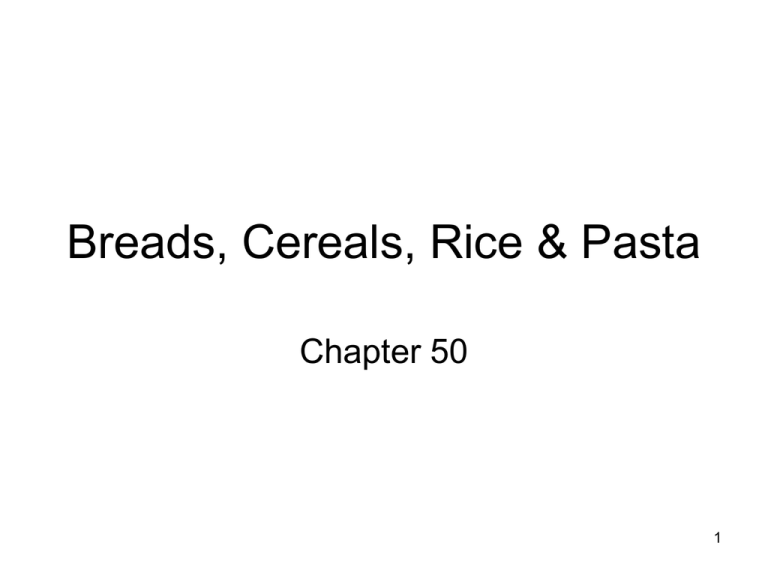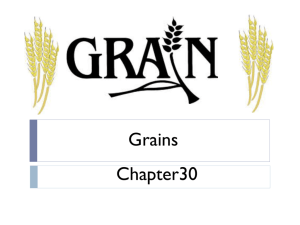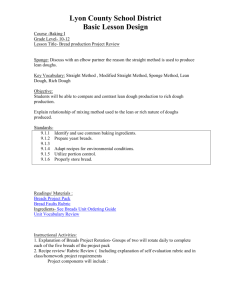Chapter 50
advertisement

Breads, Cereals, Rice & Pasta Chapter 50 1 • Most significant food group • Carbs for energy • Proteins and vitamins • Valuable source of fiber 2 Nutrient Composition • Grain kernel has 4 parts • See page 490 figure 50.1 3 • Germ (which is at its core contains vitamins and minerals • Bran – (vitamins B, E, iron, zinc) • Hull – Layers, – Protective covering • Endosperm –nourish seed if allowed to germinate – (complex carbs, protein) 4 5 • Many grain products sold in U.S. made from white wheat flour • (endosperm of the wheat) • Refined meaning bran and germ are removed – Finer texture and lasts longer – Improves nutrients – Nutrients lost in processing required by law to be replaced (enriched) 6 Fortified • Some cereals are fortified • Meaning……nutrients have been added that were not in the grain originally or were not in the grain in large amounts 7 Breads • • • • • White Whole-wheat Rye Pumpernickel Oat bran – (rolls, muffins, biscuits, loaves) 8 • • • • Commercially baked Buy bread mixes Make your own Frozen products 9 Breakfast Cereals • Made from grains such as wheat, oats, corn, rice, barley • Ready to eat (wheat flakes or rice puffs) • Cooked in water or milk • Vary in nutritional content 10 Read the Label • Whole-grain cereals a good choice • Watch out for large amounts of sugar or salt 11 Rice • White rice has had its outer covering (hull and bran) removed by polishing • Vitamin B & fiber in bran layer so it is put back in or enriched • Brown rice –hulled but still has bran – Rich in fiber, nutlike flavor 12 • Precooked (instant) made from rice that was cooked and dehydrated • Converted rice – partly cooked before bran removed—allows nutrients from bran to enter endosperm – Takes longer to cook 13 14 Pasta • Italian for “dough” • • • • Keeps its shape Stays firm Made from semolina (high in gluten) Gluten – an elastic, protein substance found in wheat flour 15 • All shapes and sizes – Little shells to wagon wheels • Made from spinach or tomatoes for color 16 17 Flour • All-purpose –(AP) – general baking/cooking • Self-rising – AP flour with baking powder and salt added • Other: buckwheat, rye, oat, whole-wheat • Cornmeal- for corn bread, tortillas, hush puppies 18 19 Storing • Breads • • • • • Best when fresh Tightly wrapped Store in cool, dark place In hot weather—keep in fridge Can freeze well (if tightly wrapped) 20 Cereals, Rice, Pasta, Flour • • • • Tightly closed packages Airtight containers Stay fresh for long periods Refrigeration not needed • Whole grain should be refrigerated, germ remaining can cause spoilage 21 • Homemade breads can be frozen for up to 3 months without losing flavor • Cool to room temperature, wrap in foil, plastic, wrap, airtight plastic bags or freezer wrap, with air pressed out of package. 22 FYI • Wheat germ is removed from grains because it contains oil that can become rancid and cause spoilage. • Wheat germ is available in vacuumpacked containers in grocery stores. • When added to foods as a topping, baking it increases food’s nutritional value, fiber content, but also fat content. 23 Preparing • Cooking in Liquids • Use water or other liquid • Package tells you how much and how long • Rice absorbs all the liquid, no nutrients lost 24 • Rice is the single most widely consumed food in the world, the mainstay of half the plant’s population. • Nutritious and inexpensive, grows in wet, marshy areas that cannot support other crops, livestock or industry. • Popularity stems from its versatility • Absorbs flavor, from spicy Indian curries to sweet rice puddings. 25 • Pasta drained and does lose some nutrients • Cook until al dente • Strain with colander • Do not rinse (lose more nutrients, need starch to hold sauce) 26 • Stored properly, commercially prepared macaroni and spaghetti will keep up to one year, noodles for about six months. • Make your own fresh pasta at home with a pasta making machine. 27 Baking • Quick Breads – Use baking soda or baking powder to rise – Ready for baking right away – Muffins, biscuits, pancakes, waffles – Liquid poured into dry ingredients – Stirred only until mixed – Over-mixing causes product to be tough 28 Quick Breads cont…. • Some biscuits rolled out and kneaded • Knead – use the heels of your hands to press the dough down and away from your body • Rotate the dough one-quarter turn, fold the dough toward you, knead again • Develops gluten 29 Yeast Breads • Breads that rise through the action of yeast, a tiny fungus—activated with warm water • Takes longer • Dough must rise • Examples – white bread, whole-grain bread, raisin bread, rolls, pizza crusts 30 Yeast Breads cont…. • Combine ingredients • Mix yeast with warm water • Active yeast releases carbon dioxide which makes dough rise • After combining, knead 8 to 10 minutes • Allow it to rise again, punch it down and let it rise again. • Test for doneness by tapping crust with knuckles • (hollow sound) 31 Microwave Cooking • Defrost or warm prepared rolls, etc • Reheat items • Baking bread possible but will be pale in color • Used for hot breakfast cereal • Not used for rice and pasta, time is just as long as stove top 32



